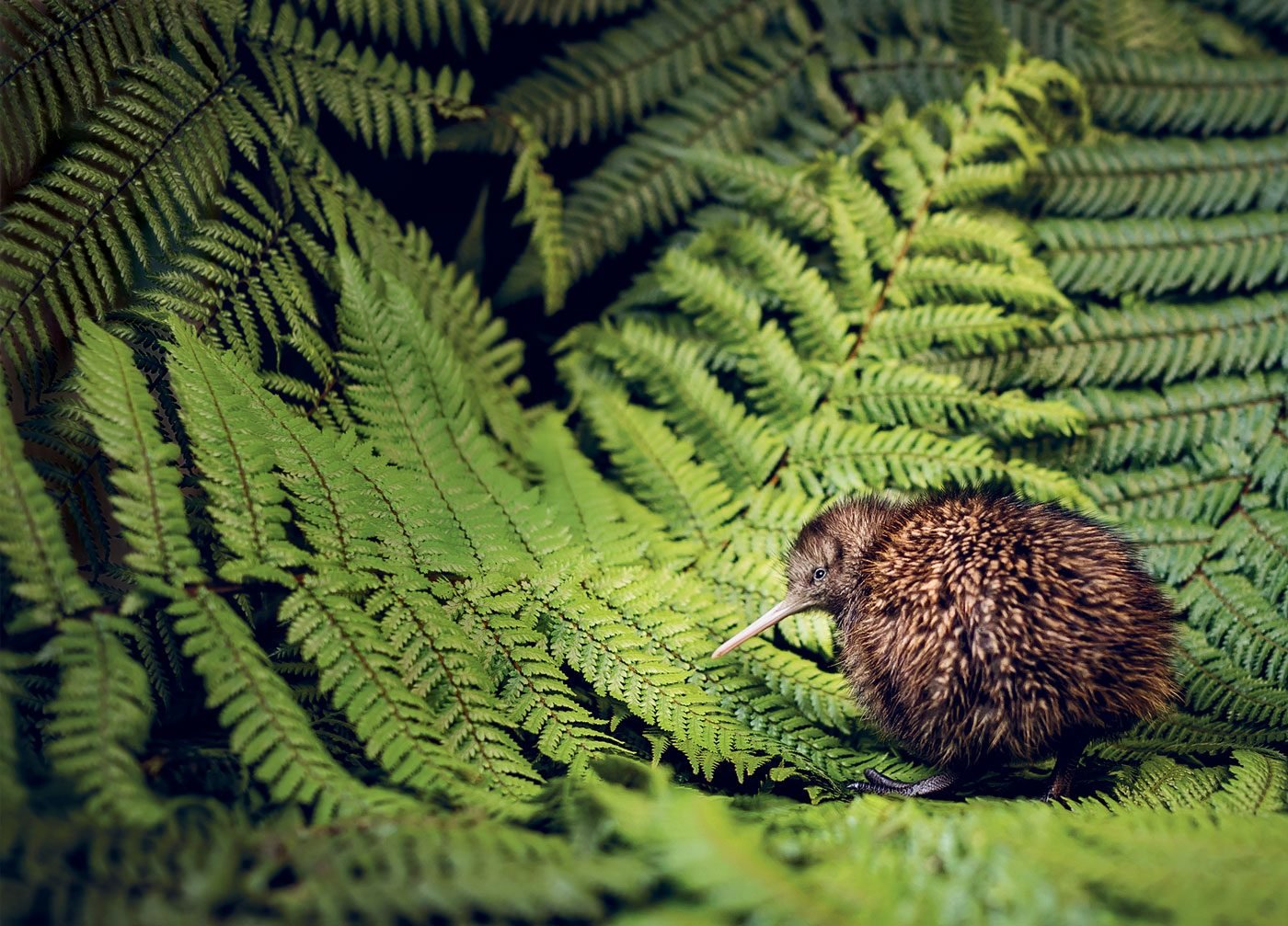
The plight of the kiwi bird
She should have found the hatchling by now. With her right arm deep in the burrow, Bridget Palmer has been groping around for a few minutes already. Her colleague, John Black, hiking boots dug into the hillside to keep from sliding in the mud, searched the burrow, too, but came up empty. The pair, volunteers with the Whakatāne Kiwi Trust on New Zealand’s North Island, are two of only six people in the organization trained to handle live kiwi birds. But as Palmer is about to discover on this overcast morning in November 2018, there’s nothing for them here.
A ranger with New Zealand’s Department of Conservation (DOC), 44-year-old Palmer pulls clumps of humid leaves out of the nest, located in Ōhope Scenic Reserve. She’s looking for eggshells, a sign that a bird has hatched. Soon, she finds a beak, feathers. Yet there’s no cause for joy—Palmer is cradling a chick’s corpse, flattened in a wad of leaves.
“Hatch death,” she murmurs.
Palmer buries the chick. After incubating for about 85 days, it became exhausted, then stuck, trying to chip its way out of the egg, which can take three to five days. The chick suffocated before being able to break free. Its sibling, Kikorangi, born two weeks earlier, and their father, equipped with a transmitter and given the name Pea, have fled the nest, probably due to the smell. Still, Palmer hopes Pea will use this burrow again. (It’s the female North Island brown kiwi that lays the eggs, but it’s the male that sits on them for three months.) At half a metre deep under sturdy tree roots, it’s a good nest.
Ōhope is one of the country’s largest remaining forests of pōhutukawa, a dome-like evergreen once used for shipbuilding and nicknamed “the Christmas tree” for its crimson flowers. The reserve is also rich in birds, such as the tūī, a dark honeyeater with white throat tufts; the melodious korimako, a.k.a. the bellbird; and the pīwakawaka, which deploys its tail in a fan shape to change directions. New Zealanders are proud of their birds, but they especially love the kiwi.
“The chick is like a big tennis ball with poof,” says Palmer. Black describes it as “a bundle of cuteness on legs.” The kiwi is the country’s most famous emblem—even hobbits can’t dethrone it. But it’s in trouble.
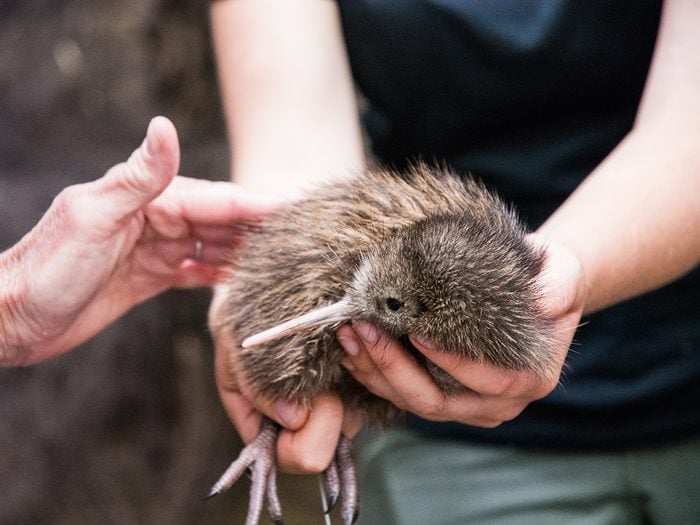
How the kiwi bird became New Zealand’s mascot
Extinction rates for birds in New Zealand are high. According to the DOC, 34 per cent of endemic land and freshwater birds and five per cent of sea birds have already been lost. Today, more than a third of bird species are considered threatened—one step away from endangered. Among them: the chicken-sized North Island brown kiwi, the most common of five recognized kiwi species and the one that lives nearest humans, mainly in low-slung coastal areas. Also facing precarity are its cousins, the rowi (the rarest, it lives mostly in the Okarito kiwi sanctuary on the South Island), the tokoeka (also called the southern brown, it resembles its northern counterpart), the great spotted kiwi (large and rugged, it prefers mountains) and the little spotted kiwi (grey and mottled, it’s the size of a bantam hen).
They all have hair-like feathers, cat-like whiskers for navigating in the dark and an amazing sense of smell thanks to a long, sensitive beak with nostrils at the tip. And although they can run quickly, kiwi are anything but stealthy: the birds’ footfall sounds almost human-like as they stomp and crash through the bush. These adorably odd, clumsy creatures are the closest thing New Zealand, with no native land mammals other than bats, has to a cuddly mascot. In total, only some 68,000 of them remain.
Many of the country’s feathered flocks evolved to live on the ground; their predators came from the sky, like the giant Haast’s eagle, now extinct. Without the gift of flight, earthbound birds like the kiwi are often defenceless against attacks from ground-dwelling animals. That wasn’t a problem until European whalers, sealers and traders began stopping by in the late 1700s, about 500 years after the Māori arrived from Polynesia. With the Europeans came rodents and kiwi enemy no. 1, the weasel-like stoat, introduced in the late 1800s to control the new but already booming rabbit population.
Of the five kiwi, the North Island browns are disappearing the fastest, largely due to deforestation. Add to that stoats, car strikes, dog and cat attacks, possum traps and the fact that nearly one-third of eggs are infertile or don’t hatch. Of the ones that do hatch, only five chicks in every 100 survive to reach the stoat-proof weight of one kilogram. Without protection, there would be a two per cent decline in population annually, and within 50 years, the North Island brown would be gone.
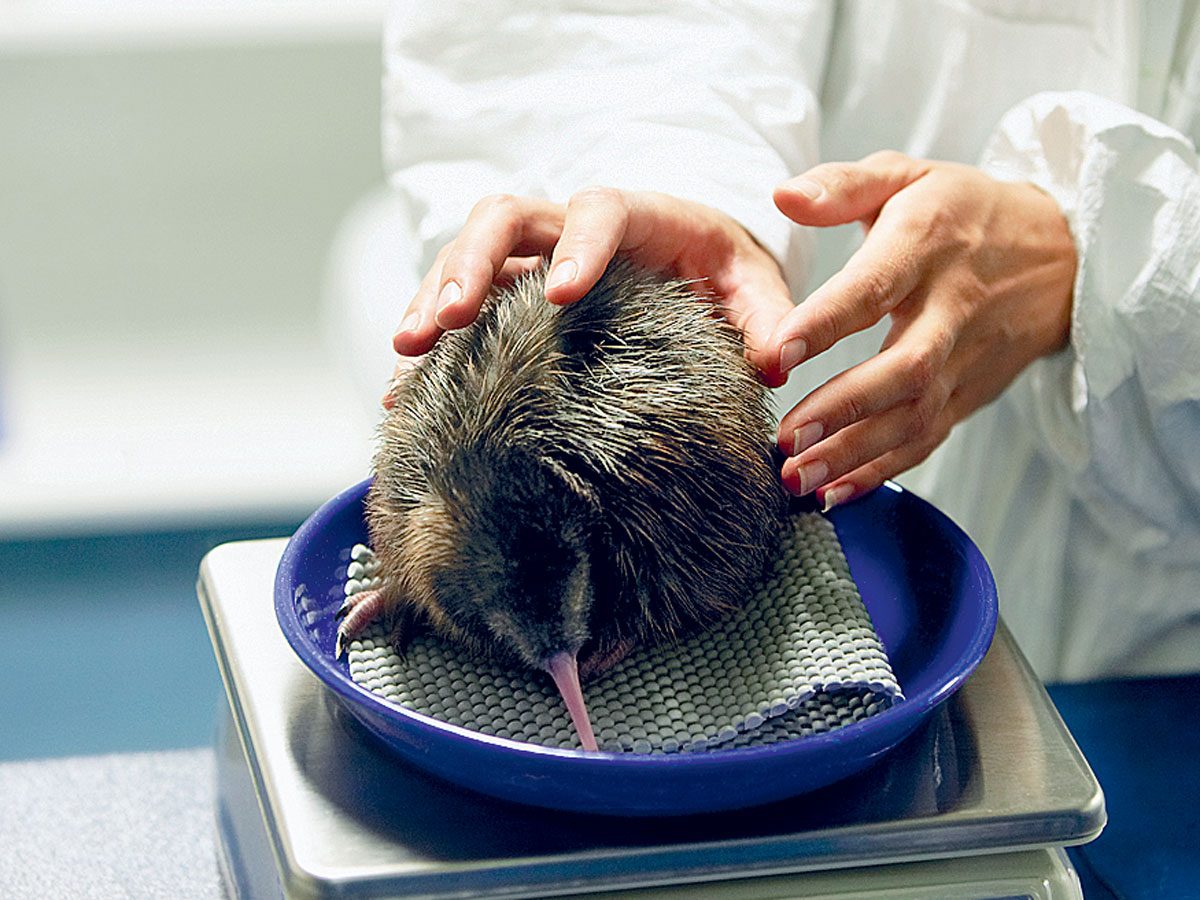
Saving the kiwi bird
That’s why Palmer, Black and a group of 130 volunteers are putting in over 5,000 hours a year to save the kiwi. Established in 2006, the Whakatāne Kiwi Trust monitors the birds for research purposes, helps the DOC with predator control and offers education in schools and to the general public. Black, a 54-year-old computer programmer, has even created an app that allows volunteers to record all things kiwi related, from hours and trapping to tracking and mapping. It’s being considered as the model for a national database.
When the DOC surveyed Ōhope in 1999, it counted only four pairs of kiwi. Thirteen years after the trust’s founding, there were over 300 birds in total, thanks in part to the removal of more than 13,000 predators, including 1,000-plus stoats and 300-plus weasels.
But the group’s trackers—nicknamed “chick pingers” for the sound their antennas make when they pick up a bird’s transmitter signal—and trappers face a quick-thinking, quick-breeding foe. From July 2017 to July 2018, a family of stoats in Ōhope was unwilling to approach a trap even for salted rabbit; the female was teaching her kits to avoid the trap and the bait, killing kiwi chicks instead. All four of Pea’s offspring that year died, which is one of the reasons the volunteers are particularly invested in his new clutch.
Pea has long been a favourite of Palmer’s; she named the bird after her mother and now sponsors him, paying $335 per year for his transmitter, which has a battery life of 12 months. With 22 adult males and 16 chicks to track annually across three reserves, the trust attracts sponsors by promising face time with the birds in their natural habitat. (Most New Zealanders have never seen their nocturnal national animal.) Pea is also a local celebrity: he is the first chick to hatch and grow up in the wild as part of the Whakatāne Kiwi Project.
Prior to 2011, when Pea was born, the trust was working with Operation Nest Egg (ONE), an initiative involving the DOC, community conservation groups, Māori, researchers and rearing facilities. Through ONE, kiwi eggs and chicks are removed from their burrows and raised in captivity until they weigh at least one kilogram, as the odds of surviving stoat attacks before reaching this milestone weight are zero. It takes about six months before they can be returned to their former territory.
After years of using ONE’s services, the Whakatāne Kiwi Project wanted to help the birds in situ by monitoring the chicks from hatch. Some seasons have been more successful than others. Palmer is disappointed by Pea’s second chick’s failure to hatch but prefers that to death by stoat. “In my mind, this is Mother Nature taking its course,” she says.
Read the fascinating story of how ocean researchers are delving into the secrets of the white shark.
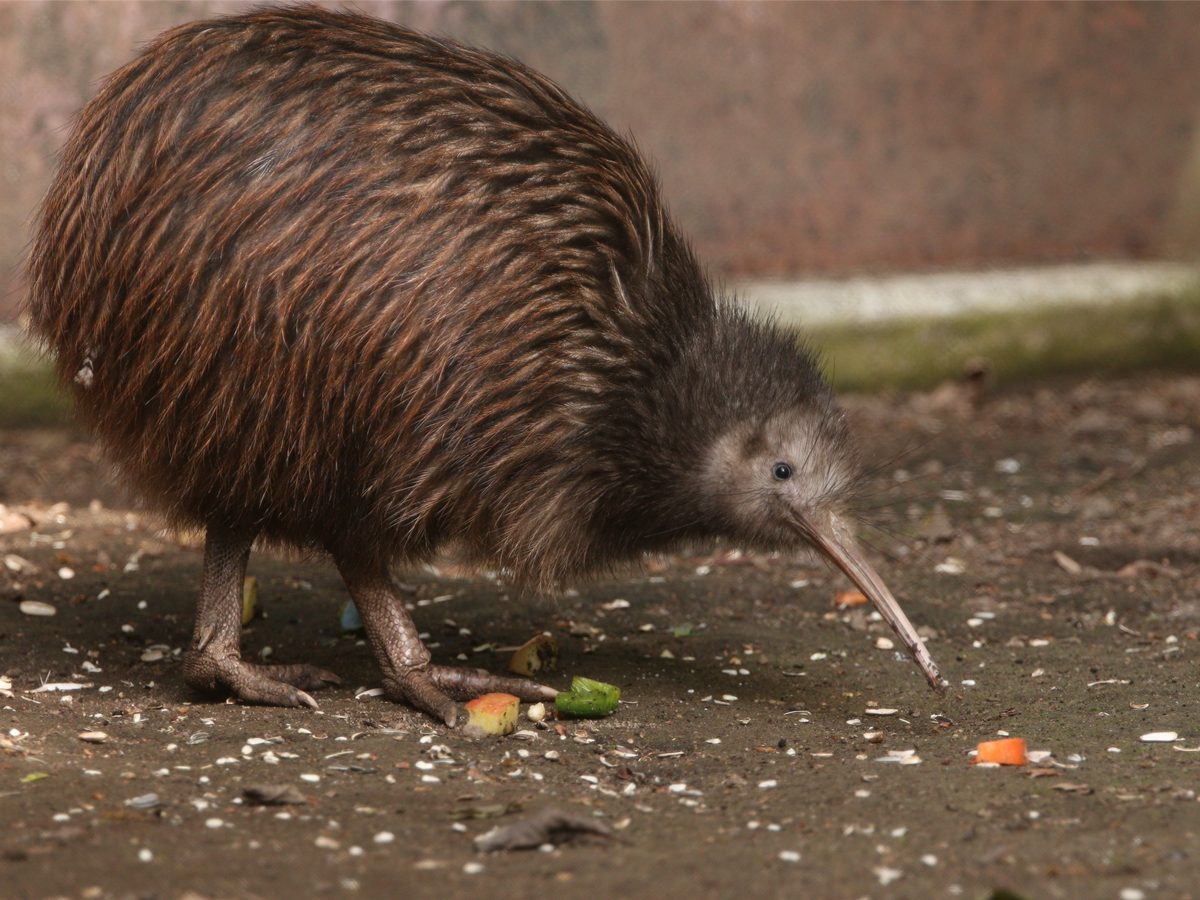
“I’m not going extinct.”
Rainbow Springs Nature Park may differ from the trust’s workspace, but its goal is the same: the continuation of the kiwi. Located in the city of Rotorua, an hour-and-15-minute drive inland from coastal Whakatāne, it’s home to the National Kiwi Hatchery Aotearoa, the world’s largest of its kind. Emma Bean, 38, is the kiwi husbandry manager there. She and her staff of seven hatch and release an average of 130 chicks each year (the average hatching rate is 95 per cent).
She knows that success is somewhat artificial, but until kiwi habitat is free of introduced predators, humans need to intervene. “If eggs arrive at 3 a.m., we’re all ready to be here,” she says, adding that within five days of birth, chicks know how to probe for insects with their long bill and are ready to wander. Brown kiwi often leave their dad’s nest after a week, while other species tend to hang around for a bit longer.
Though she’s worked at the hatchery for more than a decade, Bean remains fascinated by her charges. “Kiwi are biologically significant,” she says. Unlike most other birds, they have two ovaries, not one. Their temperature is more like that of humans: 38 C rather than 40 or 42. Their bones aren’t hollow; they contain marrow. And they can live for 50 years or more.
Kiwi also have a distinctive call, piercing for a male, raspy for a female. It’s made after sunset, then repeated 10 to 25 times. “A couple of years ago, a chick cracked open its shell and, still wet, did a massive call, followed by nine more,” says Bean. “Most kiwi are too shattered after the exertion to do that. But this little one was yelling, ‘I’m here. Yes, I need your help, but I’m not going extinct. Listen to me call.’”
You can hear these calls at Zealandia. An eco-sanctuary in the country’s capital, Wellington, its 500-year goal is to restore the valley’s forest and freshwater ecosystems to their prehuman-contact state. Just two kilometres from the city’s core, the 225-hectare conservation project shelters over 20 animal species that have been reintroduced to the valley since Zealandia’s 1999 opening. Some, like the tuatara—a reptile that resembles a lizard but whose closest relative is an animal that was around at the time of the dinosaurs—had been extinct on the North and South Islands for over a century. (Small populations survived on offshore islands.) Thanks to Zealandia, Wellington is one of few cities in the world where the diversity of native bird species is increasing, not decreasing.
Over the course of one evening here, you can see a trio of tuatara; Cook Strait giant wētās, cricket-like vegetarian insects the size of a gerbil; luminous glow worms blanketing rock faces; and any one of 40 native birds—all behind an 8.6-kilometre fence that keeps out mammalian predators. But nothing causes quite the ruckus, literally and figuratively, as the heavy-footed little spotted kiwi, the sight of which sends a flashlight-wielding tour group scurrying after it through the bush.
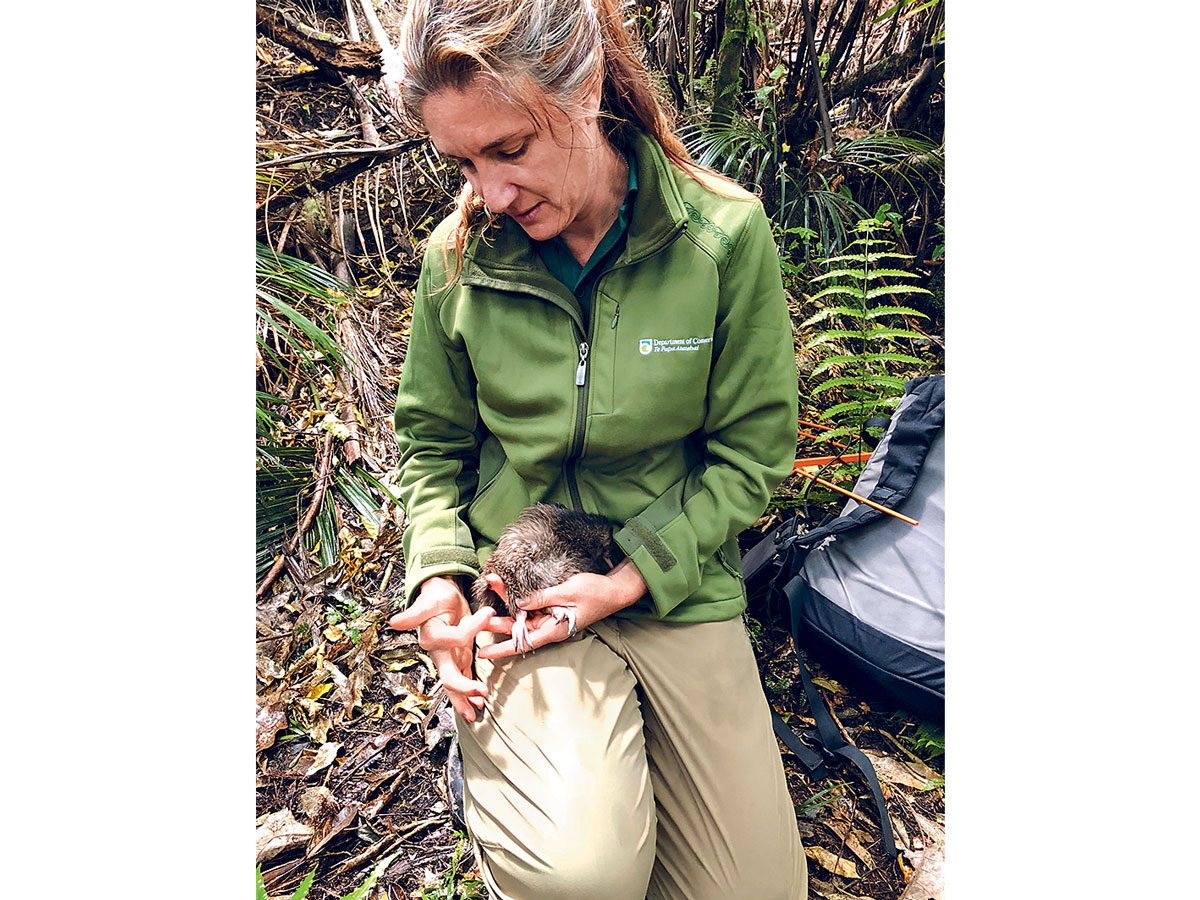
Patience and luck
Palmer and Black drive to the opposite side of the 490-hectare Ōhope Scenic Reserve, jump out of their truck, leap over a mud-filled ditch and tramp into the forest. They’re heading for the nest of Pouraiti, one of Black’s two beneficiaries. In addition to sponsoring this bird, Black has spent the better part of several nights trying to intercept his chick. Tracking is a game of patience and luck. “We’d rather wait until Dad is out,” says Palmer. “If we put our hands in there during the day, we run the risk of him abandoning his second egg.”
Thanks to a transmitter on Pouraiti’s leg, Black and Palmer know how much time he spends on and off the nest and when the egg is close to hatching, if it hasn’t already. That combined with the “candling” they conducted five days prior—a kind of ultrasound performed by shining a flashlight across the top of the shell—makes the search low-risk. They’re going in.
Palmer and Black smile at each other; they’re relieved to find a fluffy day-old chick rather than reliving the sadness they felt earlier at Pea’s nest. Black lifts the edge of the sleeve on his jacket so the squeaking newborn can plunge itself into darkness. As Black keeps a tight grip on the bird’s already fearsome claws, Palmer teases him about losing track of Chick One, which is still too small to wear a transmitter. “You know kids,” Black retorts. “Always leaving without telling you where they’re going.”
For now, at least they know Chick Two is alive. And they will be back, to name and study the young—and gather new stories to inspire others to protect New Zealand’s tenacious icon.
Next, meet the veterinarians saving mountain gorillas in Central Africa.